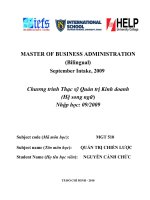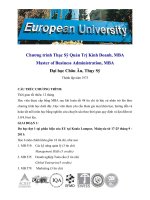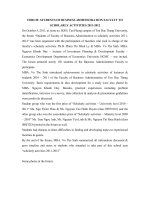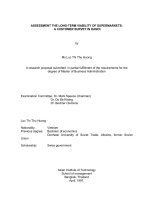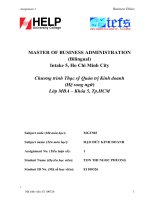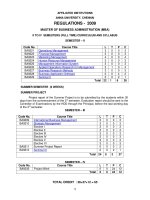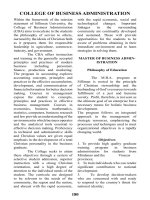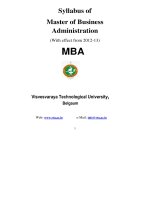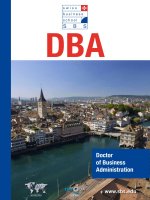Department of Business Administration MKT 355A Marketing Communications pptx
Bạn đang xem bản rút gọn của tài liệu. Xem và tải ngay bản đầy đủ của tài liệu tại đây (45.66 KB, 7 trang )
1
Department of Business Administration
MKT 355A Marketing Communications
Fall Trimester, 2009
Weekend College
SYLLABUS
Class Meeting: Fridays, 6:00-9:30 PM Classroom: TBD
Please refer to Records and Registration on the Inside Augsburg page
() for the latest information on room
assignments for your classes.
Instructor: Dave Schwain
Over 25 years marketing and sales management experience with various
product categories, types of customers, distribution systems. Fifteen years of
experience at the vice-president or president level. Size of companies ranged
from Fortune 100 to new venture start-ups. Also served on board of directors
of both for profit and non-profit organizations.
Contacting Instructor:
Feel free to contact me outside of class. You may contact me by phone either
at home (please call before 10 PM) or at Augsburg, or by e-mail. I am happy
to address class issues, as well as serve as a sounding board for career and
academic issues. Phone (Augsburg) 612- 330-1162, (H) 763-559-4828,
Internet: schwain @augsburg.edu. Fax 612-330-1607.
Instructor Office Hours:
I will be available before and after class, during posted office hours (my
office is 324 Memorial Hall), or at mutually convenient times and locations.
I want to be accessible, and will work with you to accommodate your
schedule.
Textbook: Advertising and Promotion, Belch & Belch, Eighth Edition
Case Study: UnME Jeans: Branding in Web 2.0
I have created a set of course materials at the Harvard Business Education web site. This is
an inexpensive (about $ 4.00) and easy way to obtain the case, although this way of obtaining cases
may be new to you. The following will provide you with information about the two steps you will
now take to access your course material.
To access the Harvard Business Education site, follow this link:
/>
2
If you have not registered with the Harvard Business Education site, it will be necessary to do so
now. Once you have completed the brief registration process, you will be able to log in. Once
logged in you will be able to access the case I have assigned for the course. For your reference, the
case you need are also listed at the end of this email.
The case will be available in PDF and can be viewed with Adobe Acrobat Reader. The PDF will
be available to you through your Harvard Business Education library for 6 months from the date of
purchase.
For subsequent access, you will need to login at www.hbsp.harvard.edu and go to My Library-
>Courses
I hope you find this a convenient way to access your course materials. If you have any questions
about the materials, please contact me at
For technical assistance, please contact Harvard Business Publishing Customer Service at 1-800-
810-8858 or 617-783-7700 from 8am-8pm EST. Customer Service can also be reached at
COURSE DETAILS
Professor Information:
David Schwain
Course Information:
Course Name: Marketing Communications
Course Number: MKT355 (2009TR1A)
Course Level: Undergraduate
Course Start Date: Sep 11, 2009
Expected Enrollment: 7
Reference Code: 4406825
Student Access URL:
Product Information:
Product #: 509035-PDF-ENG
Product Format: Digital
Product Title: UnME Jeans: Branding in Web 2.0
Product Type: Case
Publisher: HBS
Class Prerequisite: MKT 252 (Principles of Marketing), or permission of instructor.
Course Goals: There are three objectives for this course.
1) Examine the basic concepts of marketing communications (and the
3
inter-relationships between advertising, direct marketing, interactive/Internet
marketing, sales promotion, public relations, and personal selling).
2) Understand the disciplines associated with developing and
implementing an integrated marketing communications plan.
3) Experience the development of an integrated marketing
communications plan utilizing an individual written case analysis and
presentation.
Teaching Methods:
The course will be a combination of lecture, case studies, and class discussion.
Lectures will amplify selected subjects from the textbook, as well as provide
applications-oriented perspectives and career information. I approach this course
from the point-of-view of a practitioner. Students will be responsible for material
from lectures, the textbook, and specific handouts for examinations. I may
occasionally schedule guest speakers. Please plan to participate in class. An active
discussion is an important element of the course learning experience…it makes the
class more engaging and more enjoyable.
Course Assignments:
A list of reading assignments and the content of the course is attached. You will
also be provided with supplementary reading material, primarily from trade journals,
that relates to current events in the field of marketing communications.
Evaluation Criteria and Grading Policy:
Two tests will be given during the course, each a combination of multiple choice
(40-50 questions) and essay questions (4-5). Both test sections are equally weighted.
An additional course element is an individual brief case study paper 2-3 pages) and
a short (5-10 minutes) presentation that presents a realistic marketing
communications problem to address. The case is meant to be a capstone for the
course, providing an opportunity to solve a marketing communications challenge.
You will have an opportunity to utilize the disciplines discussed in the course,
combined with your own judgment and creativity….all three are important elements
of a successful marketing communications program. Because you may not have
completed a written case analysis before, there will be a good deal of class
discussion regarding the case. I will provide you with case study questions to help
focus your work. The case study will be submitted in two parts. These are described
later in the syllabus. I would like you to be able to focus on your case study content
without needing to “second guess” my expectations. I expect the case study to be a
professional analysis and recommendation, and that you will make a persuasive
argument for your point of view. We will discuss both the case study and
presentation in more detail during class.
4
Course grades are determined on the basis of 300 points:
Test # 1 100
Test # 2 100
Case Study 100 (First Paper 25%, Presentation 75%)
Total 300
Course grades will be distributed as follows:
4.0 92% + 2.5 72% +
3.5 86% + 2.0 58% +
3.0 79% + 0 Below 58%
Class Organization:
Make-up tests: I will allow students to make-up an exam under special
circumstances. These will be scheduled at the convenience of both the student and
myself.
Attendance: Attendance at all classes is required, particularly given the small
number of classes in the weekend college semester. Students will lose .5 off their
final grade for each unexcused absence. If a situation occurs which would warrant
an excused absence, contact me in advance of the situation. If it is an emergency,
please leave a voice mail at my Augsburg phone number explaining the situation
prior to class.
Assignments: Late assignments will reduce your final grade .5 per late assignment
per late day.
Academic Honesty: Students are expected to abide by the Academic Honesty
Policy contained in the Student Guide. I will be honest with you but expect you to
be equally honest with me. Lying about illness or emergencies is unacceptable.
Naturally, I expect your work to be your own. You will be asked to sign your
affirmation that your work is in compliance with Augsburg’s honesty policy. A
violation of the Academic Honesty Policy will result in a 0.0 for the project/test.
Disability: C.L.A.S.S. Students: I am happy to make reasonable accommodations
that you need. Please let me know you are a C.L.A.S.S. student at the beginning of
the semester.
Course Changes: I reserve the right to modify the course requirements,
assignments, grading procedure, and policies as circumstances dictate.
Student Questionnaire:
I would like to tailor the class discussion to your experiences and interests. To help
me do this, please complete the attached questionnaire and bring it to the first class.
5
Department of Business Administration
355A Marketing Communications
Fall Trimester, 2009
Weekend College
ASSIGNMENTS AND EXAM DATES
Meeting Topics Chapter
Date Assignments
Sept. 11 Class Overview/Case Assignment. 1,2
Marketing Analysis, Strategy,
Targeting, and Planning Process.
Promotional Mix, Integrated
Communications Planning Model.
.
Sept. 25 Agencies: Types, Organization, Management. 3,4
Consumer Decision-Making Process.
Positioning Exercise.
Oct. 9 Segmentation Discussion and Exercise. 7
Establishing Objectives and Budgets.
Oct. 23 Test # 1.
Creative Strategy: Planning, Development 8,9
Implementation, Evaluation.
Nov 6 Media: Planning and Strategy. 10,11,
Evaluation of Broadcast and Print Media, Support Media 12,13
Nov. 20 Promotion, Personal Selling. 16,18
Case Paper # 1 Due
Dec. 4 Test # 2.
Direct Marketing and Marketing on the Internet. 14,15,
Public Relations, Publicity, Corporate 17
Advertising.
Dec. 11 Measuring Program Effectiveness. 19
Case Presentation Due
Department of Business Administration
355A Marketing Communications
Fall Trimester, 2009
6
Weekend College
Case Study: UnME Jeans: Branding in Web 2.0
This case introduces emerging Web 2.0 social media in virtual worlds, social networking sites, and
video sharing sites, and encourages students to explore the opportunities and risks they present for
brands. The case allows students to grapple with the strategic and tactical decisions that accompany
marketing communications strategy and to combine information on consumer behavior with an
understanding of brand objectives, in order to assess and evaluate new social media options. Brand
manager Margaret Foley is facing an increasingly complex media environment in which her
traditional media plan, focused on television, print, and radio advertising, has become less effective
due to declining audiences, increased advertising clutter, and consumers tuning out. She is
exploring emerging Web 2.0 social media options to determine if they can better achieve her
branding and advertising objectives. Her challenge is to cut through all of the hype surrounding
Web 2.0 and to analyze the social media's potential for her brand by delving into the consumer
needs and behaviors underpinning Web 2.0 technologies.
Paper # 1 25 Points: Answer the following questions: 2-3 pages
A) Contrast the traditional “interruption” advertising model discussed in class with the new
Web 2.0 model of marketing communications.
B) Diagnose the problems with Foley’s current marketing communication plan, given the
changing media environment and changing consumer behavior. What are some of the
benefits and risks involved in branding in Web 2.0?
Presentation 75 Points
A) Analyze the three social media options presented by Foley’s agency, outlining the strengths
and weaknesses of each
B) Recommend a marketing communications plan for Foley by adding a “Recommended
Plan” column to Exhibit 1 in the case. Provide rationale for your recommendation (which
you can take from Q B in the first paper and Q A in the presentation.
Your presentation should probably be about 4-5 pages long and take 5-10 minutes. (One page
for each of the three social media options and 1-2 pages for the recommendation and rationale.
You may use Power Point or overheads for your presentation.
Department of Business Administration
355A Marketing Communications
Fall Trimester, 2009
Weekend College
7
STUDENT QUESTIONNAIRE
What do you hope to gain from this course?
What is your major, or what areas are you considering for a major?
What are some of your recent work experiences (employer, type of business or organization, your
role or function etc.)?
Any other comments?
Name. (Optional)
